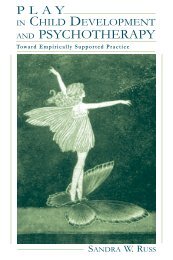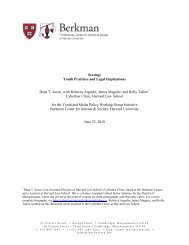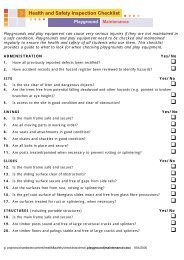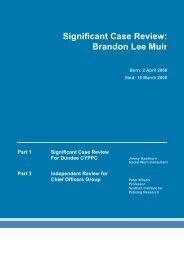Download PDF - Fair Play For Children
Download PDF - Fair Play For Children
Download PDF - Fair Play For Children
You also want an ePaper? Increase the reach of your titles
YUMPU automatically turns print PDFs into web optimized ePapers that Google loves.
5.<br />
6.<br />
7.<br />
8.<br />
The Government will work with a number of interested local authorities to sign up to a healthy<br />
community challenge fund. This will test and validate holistic approaches to promoting physical<br />
activity. Towns and cities that sign up – badged ‘healthy towns’ – will be expected to invest<br />
in infrastructure improvements to encourage physically active lifestyles and to implement the<br />
lessons of a variety of programmes.<br />
Through the national healthy schools programme, schools will be able to use children and<br />
young people’s access to active play within the school as part of their evidence for meeting<br />
the physical activity criteria. Active play could also be promoted as an essential part of healthy<br />
schools’ breakfast clubs and other outside the curriculum time activities. Healthy schools would<br />
also link to wider communities where appropriate to encourage play for their pupils.<br />
Local authorities have an important contribution to make in their ‘place shaping’ role, as<br />
planning authorities and through working in local partnerships with other agencies. Through<br />
local area agreements, they can set specific objectives for their communities. Moreover,<br />
specifically addressing diet and activity, including active play during early years will impact upon<br />
measurement of height and weight at reception year, thus influencing the delivery of LAAs<br />
which incorporate national indicators on obesity.<br />
Upcoming NICE guidance on physical activity, play and sport for pre-school and school aged<br />
children (to be published in January 09) will make a valuable contribution to the supporting<br />
the evidence base around play. Recommendations will be made for children and young people<br />
up to the age of 18 years, with a specific focus on those aged seven years and under and 11 to<br />
18 year-old girls.<br />
Transport and play<br />
Improving skills and behaviour<br />
9.<br />
10.<br />
11.<br />
A significant part of improving road safety is about improving people’s skills and behaviour<br />
when out using the roads. This includes the behaviour of children themselves, their parents and<br />
carers and all vehicle drivers and riders. We want to help all road users – children and adults<br />
– to have the skills they need to use the roads safely. This includes road safety education and<br />
training for children, driver training and testing and publicity aimed at all road users.<br />
The Department for Transport is now working with educational consultants to look at the<br />
best way to provide a comprehensive set of road safety educational resources for all age<br />
groups. This will include an audit of existing materials produced by local authorities, devolved<br />
administrations and commercial suppliers, the production of new materials (if necessary) to<br />
provide a unified set of materials that is suitable for all age groups, and a marketing strategy to<br />
encourage teachers and schools (primary and secondary) to make use of these materials<br />
Between 2002 and 2007, DfT supported a wide scale pilot of the Kerbcraft child pedestrian<br />
training scheme. This teaches children aged 5–7 the key skills they will need to cross roads<br />
safely, through practical kerbside training in the real road environment. It has been thoroughly<br />
64 <strong>Fair</strong> <strong>Play</strong>: A consultation on the play strategy




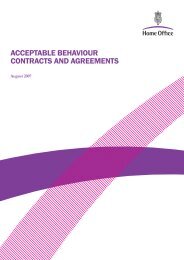
![The Childcare Act 2006 - Notes [Website] - Fair Play For Children](https://img.yumpu.com/50144819/1/184x260/the-childcare-act-2006-notes-website-fair-play-for-children.jpg?quality=85)




![Bouncy Castles [PDF] - Fair Play For Children](https://img.yumpu.com/45463572/1/184x260/bouncy-castles-pdf-fair-play-for-children.jpg?quality=85)

